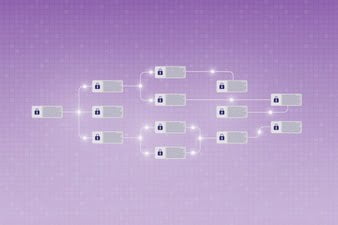A bot, or to be exact, an internet bot, is an automated program that operates on a network to automatically perform a specific task (in rare cases, several tasks). Typically, these tasks are relatively simple and repeatable. Any human can easily perform these tasks by themselves, but the main benefit of using these bots is that they can repeatedly perform the task at a much faster pace than any human user ever could.
Almost half of the total internet traffic today comes from these bots, and around 25% comes from bad bots performing malevolent tasks. However, there are actually good bots operated by reputable companies that can benefit both the website and users, so when managing bot traffic on our site, we have to take account of these good bots.
Here, we will discuss the difference between Good Bots VS Bad Bots, what to expect from them, and especially how to manage them effectively.
Good Bots VS Bad Bots: The Key Differences
The most important difference between a good bot and a bad bot is the task they perform: a good bot performs beneficial tasks, while bad bots perform malicious tasks. Further below, we will discuss examples of these tasks and the different types of good and bad bots. However, there are also some key factors to consider when differentiating between Good Bots VS Bad Bots:
1. Owner/Operator
An important distinction between good bots and bad bots is the operator: good bots are typically owned by reputable companies (think Google, Amazon) while malicious bots are owned and/or operated by hackers.
With that being said, many malicious bots are disguising their operators with these reputable companies, so it can be difficult to distinguish.
2. Compliance with rules
We can set up policies and rules of which pages can and can’t be crawled by bots, as well as other rules via robots.txt or httaccess, among other means. Good bots will always follow these rules, and bad bots typically won’t.
3. Fingerprints
Many malicious bots are disguising themselves not as good bots, but as legitimate human users. However, in these disguise attempts, they often leave certain ‘fingerprints’ such as:
- IP address or suspicious geographic location
- Headless/modified browsers
- The inconsistent browser and OS usages
- Linear, patterned mouse movements
- Repetitive patterns in filling out forms, etc.
By paying extra attention to these three factors, we can better differentiate between these good bots and bad bots.
Examples of Good Bots
As discussed, we can mainly differentiate good bots and bad bots by looking at their tasks/activities. The following are some common examples of good bots with their respective tasks:
1. Spider bots
These bots ‘crawl’ web pages to collect information. Various bots work on search engines like Googlebot, Bingbot, and others are good examples of spider bots crawling and indexing various websites so they can be featured and ranked on the respective search engines.
2. Copyright bots
Work in similar principles to the spider bots, as they also crawl websites to check their content. However, these bots are specifically looking for potential breaches in copyright. YouTube ID is a good example of copyright bots, scanning various YouTube videos for copyrighted songs, images, and footages.
3. Data bots
These bots collect data and update information in real-time. For example, bots responsible for updating real-time weather information, currency rate changes, and so on. Google Assistant and Siri are actually advanced examples of data bots.
Monitoring bots
These bots monitor various metrics on a website, for example, whether the website is currently down, changes in backlink profile, etc.
Examples of Bad Bots
Bad bots, on the other hand, perform malicious tasks such as:
1. Vulnerability Scanning/Malware Injection
These bots crawl and scan websites looking for vulnerabilities and potential opportunities for attack. The bot, for example, can inject malware of various types immediately after it has found a vulnerability on the web app. The operator can also launch more severe attacks by finding out about the system’s vulnerabilities and performing full-fledged data breaches.
2. Account Takeover (ATO)
Bots can be utilized to perform brute force and carry out other attacks to steal your credentials, attempting to gain access to a user/administrator account.
3. Web Scraping
These bots extract the content and use it for malicious purposes, for example re-publishing the content on another website to ‘steal’ the original site’s traffic and SEO performance. Also, the operator can leak scraped information to competitors and to the public.
4. Spam
These bots leave automatically generated spams, commonly including links to the operator’s fraudulent websites.
How To Manage Bad Bots
The most effective way of filtering out bad bots from good bots is to use proper bot management strategies and software to do the job.
If you are looking to remove the harmful effects of bots from your digital and tech world, experts suggest three major suggestions or strategies to doing the same-
1. Using a Signature or a Finger Print based Scanner-
As a user, you need to understand that there are a number of ways in which a bot management solution works. The first and most common way is creating a digital signature by tracing the IP of the source. This helps in creating a digital fingerprint-like scanner and allows you to exactly understand the source of the origin. If the source is problematic, the software solution sounds an alarm and takes the necessary steps to eliminate the danger.
2. Solutions based on Challenge-
How many of us have seen the famous or highly irritating ‘CAPTCHA’ whenever we use or try to open a website. While we humans feel that the tests are too stupid, when it comes to bots, the system has been highly successful in evading their intelligence. This continues to be one of the most effective ways to keep bots out of your digital platforms.
3. Human Behavior Checking Solutions-
Human beings have a way in which they use computer systems. The movement of the mouse, the clicks, the time is taken, scrolling behaviors, etc. allow the software to understand that whether it is the human being who is assessing a website or a bot is. If it catches a pattern that is used by bots, exact horizontal or vertical flows of the mouse, cursor, and scroll, it locks them out.
Conclusion
You need to understand that the individuals or agencies, which make these bad bots are using the most sophisticated and advanced piece of technology to bypass security systems, According to DataDome, one of the foremost agencies experimenting with Artificial Intelligence and Machine Learning, bad bots should be taken seriously as they can come laden with other dangerous elements like malware and ransomware.
Read Also:































